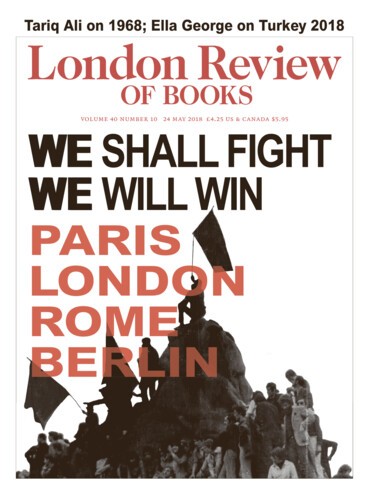One of the most evocative objects in Ocean Liners (at the V&A until 17 June) is a diamond and pearl tiara by Cartier. Not particularly spectacular as Cartier tiaras go, it was once the property of Lady Marguerite Allan, who took it with her when she sailed from New York on 1 May 1915 on board the Lusitania. Six days later, off the Irish coast, a German U-boat torpedoed the ship, which sank in 18 minutes with the loss of 1198 lives. Among the survivors were Lady Marguerite and her maid, who, professional to the last, kept a firm hold on the tiara until it reached dry land. If the great age of the liner was one of glamour, ‘speed and style’, as the exhibition’s subtitle has it, drama and catastrophe are also part of the allure. Ocean Liners includes an example of that now largely metaphorical object, a deckchair from the Titanic.
Before the First World War, liners were designed to conceal as far as possible from passengers the fact they were at sea. The Lusitania was styled like a floating country house. With stuccoed ceilings, stained glass, palm courts and grand pianos, it looked as if it might sink under the weight of the furniture. The deck was a merely functional space for the crew. After 1918 things changed. Modernism, as well as a fashion for fitness and outdoor living, saw the situation reverse to the point where avant-garde houses were made to look like ships, with rails, portholes and decks or ‘sleeping porches’. Arthur Bliss’s house Pen Pits, built in 1935 well inland in Somerset, featured exterior ladders from roof to sun deck. Meanwhile in real ships the deck became as much a social space as the interior, swimming pools were moved outdoors and decor streamlined. Most modern of all was the Orion, designed by Brian O’Rorke for the Orient Line in 1934. O’Rorke declared war on ‘plush and chintz’, instead using Bakelite, chrome and fabrics by Marion Dorn. The Orion was ‘the first British ship to truly adopt modernist principles’ and was probably what Evelyn Waugh had in mind in Brideshead Revisited: ‘Yards and yards of biscuit-coloured wood … that had been bent round corners … blotting paper carpet’ all ‘designed perhaps by a sanitary engineer’.
The V&A’s principal exhibition space has always been awkward, divided as it is by a corridor, but since the hugely successful Alexander McQueen show, imported from New York in 2015, demonstrated what could be done with it, the museum seems to have a new spring in its step. The exhibition design deftly conveys the twists of history by way of contrasting spaces which take visitors through the early years of heavy fittings and experimental engineering, beginning with Brunel’s Great Eastern, on along a ship’s rail and back projection of a sparkling sea on which the Queen Mary seems to sail by, to emerge in the double-height gallery that covers the interwar years, the heyday of stylish sea travel. Black and white film re-creates the central staircase of a first-class dining room, the focal point for onboard society, down which passengers ‘drifted’, as a description of the Paris in 1921 put it, under the eyes of languid bystanders, leaning out from swirling art nouveau galleries to watch ‘a world … where life moves with savoir faire and fascinating amiability’. Essays in the book which accompanies the exhibition, explore ‘the idealised society of the ocean liner’ and ‘fashion and spectacle on board’ in more detail but the individual exhibits are telling enough. Among the flotsam of the golden age are bathing costumes in constructivist patterns, the Dior suit worn by Marlene Dietrich arriving in New York on the Queen Elizabeth and a pile of suitcases discreetly labelled ‘The Duke of Windsor’.
The more surprising items include an Art Deco Torah ark from the Queen Mary, looking like a sideboard in the throes of a spiritual crisis, and the blue and gold Madonna of the Atlantic, by Kenneth Shoesmith, which was wheeled into the first-class drawing room on Sundays for Catholic mass. The Queen Mary was perhaps the most stylish of the British liners. Cunard, wary on the one hand of cutting-edge functionalism while resisting on the other ‘the flashiness of a Grand Babylon Hotel’, commissioned work in a gentler vein which reflected the picturesque character of British modernism between the wars. Doris Zinkeisen’s murals in the Grill Room on the theme of entertainment had Josephine Baker and Mae West rubbing shoulders with Punchinello. It didn’t last long. Within a few years the Queen Mary had become the ‘grey ghost’, the ‘most effective troop ship’ of the Second World War. First-class cabins designed for two were straining to accommodate twenty soldiers.
After 1945 it was never the same. Air travel increasingly made the liner an indulgence without a destination, merely a cruise. The exhibition continues up to the 1960s with David Hockney’s Pop Inn ‘a dedicated space for teenagers’ on the Canberra, which looks as unconvincing as it sounds. Then, the final falling off, the behemoths of Disney and Royal Caribbean which can each carry 6750 of the 24 million people who took cruises in 2016. Designed with ‘intentional’ homogeneity to appeal to the mass market, they are moving ‘ever closer to the reality of a self-sustaining city’ where, like the Edwardians, nobody need know they are at sea.
Send Letters To:
The Editor
London Review of Books,
28 Little Russell Street
London, WC1A 2HN
letters@lrb.co.uk
Please include name, address, and a telephone number.


